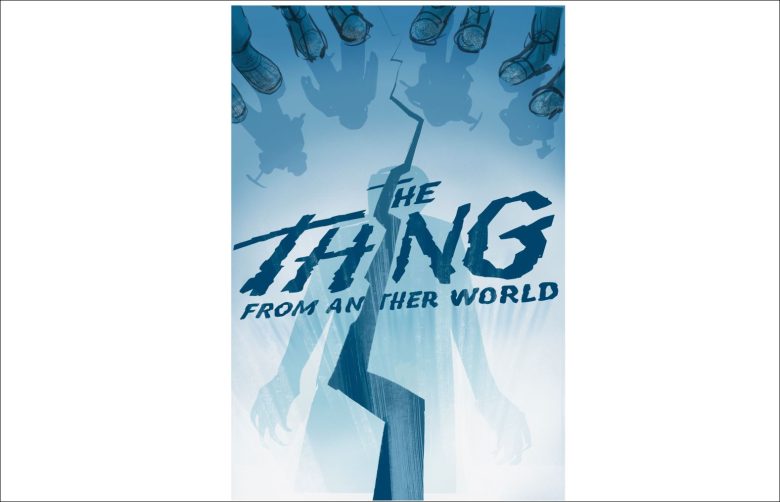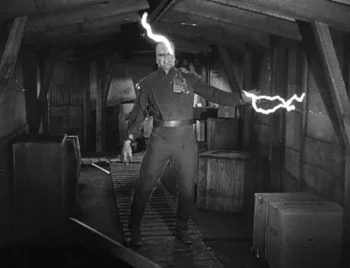@triggerwarningillustration (link: https://goo.su/HNvjN)
The Thing from Another World
by Eric Lindbom –
Lately, John Carpenter’s THE THING has slithered beyond gorehounds into the Zeitgeist. TRUE DETECTIVE: NIGHT COUNTRY (HBO MAX) was practically a homage. Cuddly late-night host Stephen Colbert has dubbed THE THING his go-to, comfort food film. Super fan Boon Joon-ho recently agreed to have Carpenter score his next movie. THE THING keeps enthralling us due to several factors. Rob Bottin’s hand-made FX (with tactile ingredients like mayo, strawberry jam, and KY Jelly!) brings freak show terror with its fused corpses. (Who can forget a decapitated head sprouting spindly spider legs?). Bill Lancaster’s script oozes with paranoia. Since the morphing beastie possesses human hosts, the Arctic outpost’s trapped characters have major trust issues with each other as their numbers dwindle.
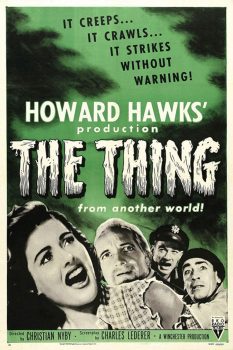
Today, Carpenter is among the growing contingent who believe THE THING has transcended his pioneer slasher HALLOWEEN and his trenchant action thriller ASSAULT ON PRECINCT 13 as his apex. Such acclaim makes it easy to forget THE THING’s uneasy arrival. Its ambiguous, downbeat ending, very ‘70s style, was out of step with 1982 and the sunny early Reagan years. It hit screens two weeks after the blockbuster sci-fi weepie E.T. THE EXTRA-TERRESTRIAL made space aliens seem like comfy plush dolls. Critics lambasted Carpenter’s THE THING for its supposed “wretched excess,” and audiences were wary. In a reversal, for a new generation of fans, Carpenter’s THE THING has leapfrogged the original 1951 THE THING FROM ANOTHER WORLD (an affordable rental via Amazon), which holds a spot on the National Film Registry and a comfortable perch on any top five list of ’50s sci-fi films.
Here, I plead guilty to being mealy-mouthed. I not only won’t pit Don Siegel’s blacklist-era INVASION OF THE BODYSNATCHERS against Philip Kaufman’s ‘70s New Age take; I won’t even cast a vote in the never-ending Charlie Chaplin vs. Buster Keaton or Beatles vs. Rolling Stones debate. To me, it’s A-OK to adore both THINGs. To prevent the elder from being
mothballed in our minds, it’s worth noting that it is equally remarkable for different reasons. Any analysis of THE THING FROM ANOTHER WORLD can’t avoid the ongoing debate over who directed it. While Christian Nyby bears the on-screen credit, there is credible evidence from on-set participants that producer Howard Hawks shadow-directed it. Nyby denied it while allowing that Hawks’ style influenced him, and admitted he often sought his advice during
production. Hawks also rejected the claim but kept three-fourths of the director’s fee! (Some speculate he wanted to gain Nyby, an editor on three previous Hawks’ films, entry into the
Directors Guild.)
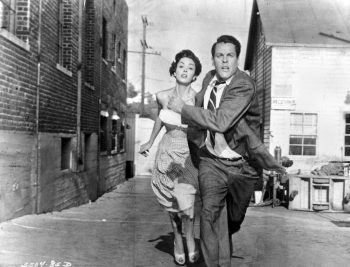
In any case, THE THING bears many of Hawks’ directorial traits, including a breathless pace,an able juggling of an ensemble cast, jocular male camaraderie, and rat-a-tat dialogue. The story begins as Air Force Captain Pat Hendry (Kenneth Tobey) in a cool black leather jacket, jaws in jokey fashion with his flight crew at an Alaskan command center. They’re assigned to investigate a North Pole outpost where Nobel Laureate Professor Carrington (a deliciously condescending Robert Cornthwaite) has encountered a strange phenomenon. Upon arrival, Hendry is re-acquainted with Carrington’s assistant Nikki Nicholson (a seductively playful Margaret Sheridan). They recall their first amorous encounter, when she drank him under the table (!) while complaining about his ‘octopus’ hands. Usually, fright fans cringe through obligatory romance scenes in ’50s horror. Instead, Tobey and Sheridan have electric
chemistry, and the dialogue sings. One can imagine Bogart and Bacall handling the same lines as they did in Hawks’ TO HAVE AND HAVE NOT and THE BIG SLEEP.
With pushy, witty journalist Ned Scott (Douglas Spencer) along, Hendry and his crew fly over the imprint of a flying saucer buried under the permafrost. To Professor Carrington’s disgust, they destroy the craft trying to blast it free with thermite explosives, but exhume its lone occupant, encased in a block of ice, and take it back to the outpost. When the alien, a bald, violent hulk (played by future GUNSMOKE star James Arness), is accidentally thawed via an electric blanket, it turns violent. Soon, the outpost is split into factions — Hendry tries to protect his crew from the alien while Carrington and his fellow scientists aim to preserve and study it.
Classic STAR TREK fans will cozy up to Hendry’s crew, whether the radio operator or the co-pilots. Each displays resourceful teamwork, and they’re a relatable bunch. Conversely, most of the film’s period sci-fi rivals often feature over-earnest scientists, one-note military men, and attractive but boring leading ladies, not helped by an industrial film tone that plays like kitsch these days.
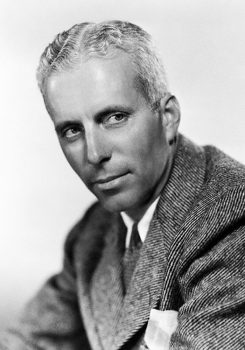
Hawks and Nyby don’t shy away from horror elements, unlike more buttoned-down, Eisenhower-era sci-fi. Since the alien’s cellular structure is vegetable-based, they delve into potent shocks minus skin and bone gore. In one scene, one of its arms is ripped off by a sled dog, and the amputated appendage later comes back to wriggling life. In another sequence, after the creature kills a sled dog, its canine corpse is found with its blood siphoned off, implying The Thing has a vampiric need to prey on the characters. Off camera, we learn the creature murdered two scientists, slit their throat and hung them upside down! Because Hendry and his crew battle The Thing with crude, nuts and bolts weaponry, instead of low-fi gizmos, their encounters aren’t dated. Kinetic action scenes abound, including one where The Thing is doused with kerosene, lit on fire, and then hurls itself through a window. In another, The Thing is caught in a door and subjected to a nasty manicure. THE THING FROM ANOTHER WORLD was adapted from the ‘30s novella WHO GOES THERE? by John W. Campbell, and, as team Carpenter never tires of pointing out, his version is more faithful to the source material. Still, it’s hard to quibble with the work here by screenwriter Charles Lederer. He is assisted by Hawks and playwright and screenwriter Ben Hecht, who wrote THE FRONT PAGE and Hitchcock’s NOTORIOUS — quite a gold-plated screenwriting team, especially for matinee movie horror/sci-fi.
Their writerly skill shines as the film concludes with a poetic speech from reporter Ned that buffs know by heart:
“Tell the world. Tell this to everybody, wherever they are. Watch the skies everywhere. Keep looking. Keep watching the skies.”
Eric Lindbom is a hardcore horror buff with a strong stomach, weaned on the Universal classics from the ’30s and ’40s. He’s written film and/or music reviews for City Pages, Twin Cities Reader, LA WEEKLY, Request magazine and Netflix. He co-edits triggerwarningshortfiction.com, a site specializing in horror, fantasy and crime short stories with illustrations by co-editor John Skewes. He lives in Los Angeles.


